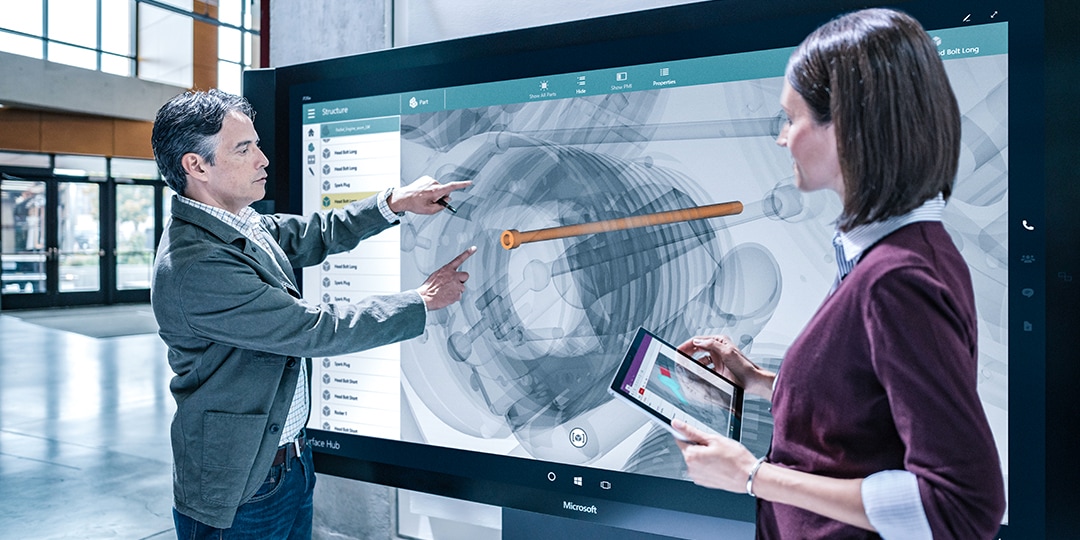April 30, 2018
Weighing the Costs and Benefits of the Microsoft Surface Hub — Part 2
Organizations considering the Surface Hub or another collaborative whiteboard should look at the device’s price and features, as well as their IT environment.

Some innovative technologies come onto the market without a clearly defined use case (or, perhaps, a clearly marketed one). They pull together features from other technologies and combine them in a new way. And while this hybrid isn’t a great fit for the original workplace settings it was pulled from, it offers opportunities for creating new use cases that no one realized existed. The conclusion I reached in my first post about the Surface Hub is that it may be that kind of device.
With the price point of the 55″ coming in at $9K and the 84″ at a whopping $22K, one must wonder if the cost can be justified. Assuming that you need something that fulfills any of the use cases discussed in my last blog post, you should take into account the cost of the competitors, including the Cisco Spark Board and Google Jamboard. The 55″ Spark Board comes in at only $5K and Cisco also has a 70″ model at only $10K, but both also have a pretty hefty monthly subscription cost along with them at about $200/month.
Google’s 55″ Jamboard is right at the same mark of $5K but has a lower subscription cost. The Surface Hub also has additional cost. You will need to enable a user account for Skype for Business and Exchange, so depending whether you are on on-premises, hybrid or Office 365, you will need appropriate licensing, including a calling plan if you use Microsoft Phone System, assuming that you plan to make calls to/from the unit. Just taking a rough estimate, that puts it at about half of Google’s yearly maintenance cost of $600.
You could also compare the packaged costs of purchasing a digital whiteboard, videoconferencing unit and Windows PC (albeit at the loss of the tight integration if you went that route). With so many options out there in each of these categories, I’m just going to rough it out at a conservative $2K for the whiteboard, plus $3K for the videoconferencing unit, plus $1K for the PC, equaling $6K total.
Leaving out the 84″ model, as neither Cisco nor Google has anything even close to that size, in either of these cases, the Surface Hub is still decently more expensive than its competitors. So, is it worth it? Let’s look a little deeper at the competitors.
Compare and Contrast
First things first, the usability of these products will be vastly affected by the communications platform in play at your organization. If you are a Google G-Suite shop, Jamboard is going to work a lot more seamlessly for your users than the alternatives and Cisco Spark Board is not exceptionally useful unless your organization uses Cisco Spark. For you to get the biggest value from your Surface Hub, general usage of Skype for Business (and soon to be Teams) is really something you should be thinking about.
Second, each product has a strength that it focuses on. Cisco’s focus on the Spark Board is to make the meeting experience be all that it can be, however, other than a whiteboard and screen presentation, there are no productivity applications available. Cisco states that this is by design and when you use one, the simplicity of its usage comes through.
Jamboard appears to split the group with its relative simplicity but still gives access to productivity applications. I wish I could expand on the Jamboard more for you, but alas, I have not had an opportunity to dig beyond product specs and YouTube videos. With my primary focus on Cisco and Microsoft Collaboration, the majority of my time is spent there (and trust me, there is enough going on in each of those spaces to keep anyone busy!) That leaves us at the Surface Hub.
It almost appears to want to be able to be all things to all people, (especially if all people are Skype people, when it comes to the meeting experience). It has by far the most features and has been extended with applications beyond anything the other products have available.
Still, each has at its core a whiteboard and a video conference unit and monitor. Each offers the ability to wirelessly project your screen to it: Jamboard through Google Cast; Surface Hub through MiraCast, Google Cast and Airplay; Spark Board through the Cisco Spark App. The whiteboard functionality between the Surface Hub and Jamboard appears to be pretty similar though, with the ability to search for images on the web and automatically fix a line drawing to a shape.
Jamboard adds a pretty nifty little feature though, where it can use Optical Character Recognition (OCR) drawn text; my guess is that would be pretty handy later on for searching for that important whiteboard session. The Spark Board whiteboard is what you might expect from an average digital whiteboard as far as features go: no frills, just a digital whiteboard. As I mentioned earlier, where the Spark Board shines is making things very low effort, tying the whiteboard into a Spark space. Today, you need to save off your Surface Hub whiteboard manually if you want to save it; I expect things may change as Teams comes into the picture.
Check out part 3 of my blog series on the Surface Hub.
